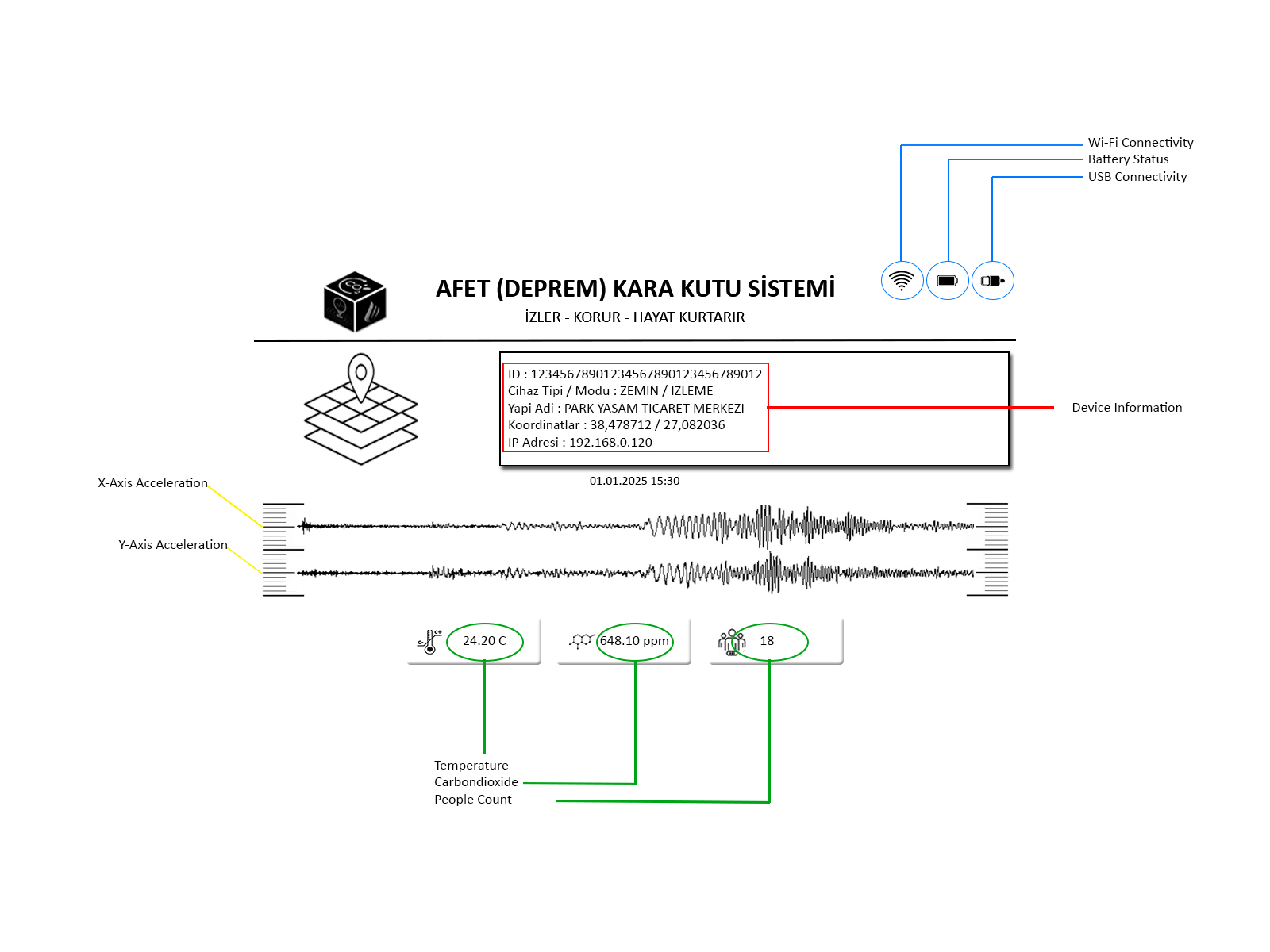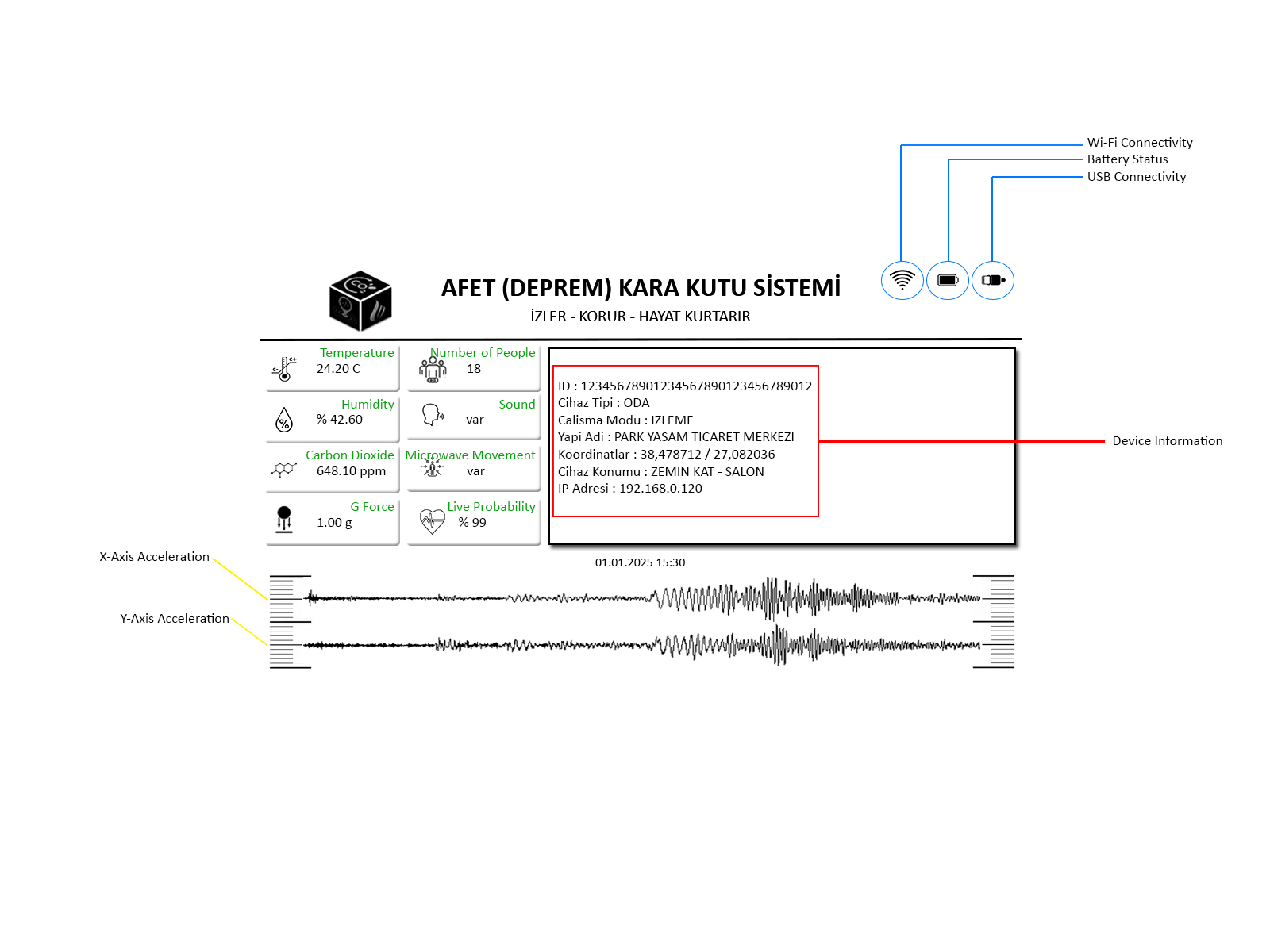Disaster Black Box System - How it works
How it works ?
Disaster (Earthquake) Black Box System basically works in 3 (three) different modes.
These are
- MONITORING Mode
- PROTECTION Mode
- RESCUE Mode
In this mode, all devices monitor seismic activity, equilibrium activity, air quality, temperature and humidity levels, noise levels, live activity and the total number of people in the building. This monitoring is repeated in 1 minute periods. If no data that poses a risk is obtained, it sends the current data numerically to the server in 1 hour periods.
If any of the devices (Floor, Room, Roof) obtains data that is considered to be risky, the devices switch to protection mode and instantly transmit this data to the server.
If only one of the devices obtains risky data, for example, a room device detects unhealthy air. In this case, only that device gives a local warning.
If any of the devices detects a risk such as fire, earthquake, tsunami, flood, explosion, etc., all devices are triggered to protection mode. Warning is provided throughout the building.
In case of destruction or damage to the building, all devices switch to RESCUE mode. In this mode, all devices work at full capacity for 10 minutes and rest for 10 minutes each. They search for live data up to a diameter of 2 to 7 metres (according to the destruction conditions) in their environment. They evaluate the live data as a percentage and transmit it to the server. In recovery mode, the server data becomes publicly available to all registered aid organisations. In recovery mode, the devices are designed to operate for at least 72 hours.
Which Protections Does It Provide ?
The disaster earthquake black box system can perform a large number of monitoring and protection at the same time with many sensors on it.
- Earthquakes
1. Seismic Mobility and Building Stability Measurement
2. Earthquake classification according to modified Mercalli Intensity Scale
- Fires
1. Fire probability calculation by measuring the amount of carbon dioxide in the environment
2. Fire probability calculation with temperature increase in the environment
3. High accuracy of fire calculation with measurements of temperature and carbon dioxide content.
- Explosions
1. Sudden and short-term Concussion monitoring
2. Monitoring sudden and short-term temperature increase
3. Monitoring sudden carbon dioxide increase
- Air Pollution
1. Monitoring of the 1st reference value of the carbon dioxide content (Ventilate the environment)
2. Carbon dioxide amount 2nd reference value monitoring (Unhealthy Air)
3. Carbon dioxide amount 3rd reference value monitoring (Insufficient Air or Fire Risk)
- Tsunami
1. Small-scale concussion monitoring with long-term upward trend
2. Fast Moisture increase tracking
- Flooding
If the reference value for humidity increase refers to flooding or inundation
- High Noise
If the ambient noise is above the monitoring reference value
- Thief Warning
1. Microwave motion tracking (only tracks live movement)
2. Ambient noise monitoring (timbres other than human voice)
The functional operating modes given here are for general purposes and the reference values and algorithms used in the system are trade secrets.
Protection and Rescue Criteria
General protection (Warning) data criteria.
Evaluation of accelerometer data
| Earthquake Scale | Acceleration (g) | Speed (cm/s) | Perceived Shaking | Destruction Potential |
|---|---|---|---|---|
| 1 | < 0.0017 | < 0.1 | Unfelt | NO |
| 2-3 | 0.0017 – 0.014 | 0.1 – 1.1 | Very Low | NO |
| 4 | 0.014 – 0.039 | 1.1 – 3.4 | Low | NO |
| 5 | 0.039 – 0.092 | 3.4 – 8.1 | Centre | VERY LOW |
| 6 | 0.092 – 0.18 | 8.1 – 16 | Powerful | LOW |
| 7 | 0.18 – 0.34 | 16 – 31 | Very Strong | MEDIUM |
| 8 | 0.34 – 0.65 | 31 – 60 | Heavy | MEDIUM and HEAVY |
| 9 | 0.65 – 1.24 | 60 – 116 | Severe | HEAVY |
| 10+ | > 1.24 | > 116 | Extreme | VERY HEAVY |
| Criteria | Value |
|---|---|
| Carbon dioxide threshold value | > 4000 ppm. |
| Temperature threshold value | > 50 °C. |
| Simultaneous detection of both threshold values. | %99 |
| Criteria | Value |
|---|---|
| Carbon dioxide threshold value | > 4000 ppm. |
| Temperature threshold value | > 50 °C. |
| Concussion threshold value | > 0.014 - 0.039 |
| Criteria | Value | Result |
|---|---|---|
| Carbon dioxide threshold value | < 1500 ppm | HEALTHY AIR |
| Carbon dioxide threshold value | < 3000 ppm | UNHEALTHY AIR |
| Carbon dioxide threshold value | < 4000 ppm | LOW OXYGEN |
| Carbon dioxide threshold value | >= 4000 ppm | INSUFFICIENT AIR FOR BREATHING |
| Criteria | Value |
|---|---|
| Concussion threshold value | >= 0.0017 - 0.014 --- < 0.039 - 0.092 |
| Humidity threshold value | >= %70 |
| Criteria | Value |
|---|---|
| Humidity threshold value | >= %65 |
| Criteria | Value |
|---|---|
| Audio Signal threshold | >= %65 |
| Criteria | Value |
|---|---|
| Audio Signal threshold | > %10 |
| Microwave Movement Detection | logic 1 |
General rescue criteria.
The system works on the principle of utilising the gaps formed in the collapse in case of a collapse is detected in the structure. It has a durable outer body and a compact design that will move with the demolition.
It can detect microwave motion up to 1-7 metres in wide gaps and up to 1 metre in gaps with obstacles.
It can track sound tracks. Sound tracks do not filter noise. For this reason, even sounds made by a stone or a foreign object are recognised as the presence of a sound track.
It can calculate breathing by measuring the amount of carbon dioxide in the cavities.
Each of these three criteria is considered as 33% vital data.
33% viability if 1 of the criteria is met,
66 per cent viability if 2 of them have been achieved,
If 3 of them are detected, 99% of them are considered as living beings.
Cost Calculation Tool
You can calculate the approximate cost of the Disaster Black Box System by entering the characteristics of your building ...
CALCULATEDocuments
About Us
Canguvenligi Profesyonel Bilisim Sistemleri A.S.
bilgi@cps-soft.com.tr
Yali Mahallesi. 6523 Sokak
Park Yasam Ticaret Merkezi 32CB Zemin Kat
Karsiyaka / İZMİR / TURKIYE





